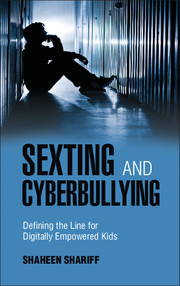Book contents
- Frontmatter
- Dedication
- Contents
- Preface
- Acknowledgments
- Chapter One Confronting Cyberbullying
- Chapter Two Sexism Defines the Lines between Fun and Power
- Chapter Three The Irony of Charging Children with Distribution of Child Pornography
- Chapter Four Keeping Kids Out of Court: Jokes, Defamation, and Duty to Protect
- Chapter Five From Lord of the Flies to Harry Potter: Freedom, Choices, and Guilt
- Appendix A Charting Out Canadian and U.S. Anti-Bullying Legislation (as it Applies or Can be Applied to Cyberbullying Incidents)
- Appendix B Expanded DTL Research Data
- Appendix C Sample Workshop Provided to Undergraduate Students at McGill University
- Appendix D Public Policy, Law, and Digital Media (Sample University-Level Course)
- Index
- References
Chapter One - Confronting Cyberbullying
Are We Any Wiser?
Published online by Cambridge University Press: 18 December 2014
- Frontmatter
- Dedication
- Contents
- Preface
- Acknowledgments
- Chapter One Confronting Cyberbullying
- Chapter Two Sexism Defines the Lines between Fun and Power
- Chapter Three The Irony of Charging Children with Distribution of Child Pornography
- Chapter Four Keeping Kids Out of Court: Jokes, Defamation, and Duty to Protect
- Chapter Five From Lord of the Flies to Harry Potter: Freedom, Choices, and Guilt
- Appendix A Charting Out Canadian and U.S. Anti-Bullying Legislation (as it Applies or Can be Applied to Cyberbullying Incidents)
- Appendix B Expanded DTL Research Data
- Appendix C Sample Workshop Provided to Undergraduate Students at McGill University
- Appendix D Public Policy, Law, and Digital Media (Sample University-Level Course)
- Index
- References
Summary
The notion of being “sage – good, wise, careful, in line with rules and expectations – is reflected in the picture of the reasonable person in the private law of civil wrongs. “Fun” is necessarily limited by “sagesse”: self-fulfillment is necessarily shaped by the obligation not to hurt others. As children explore themselves and their surroundings, gradually becoming aware of others in their lives, they begin the move beyond the realm of “carefree” and into that of “caring.” The obligation to care for others is slowly added throughout childhood to one’s sense of self.
(Van Praagh, 2007, p.63)Introduction
The opening quote by my colleague Shauna Van Praagh (2007) contains in a few sentences the essence of issues I grapple with in this book. It is about understanding the choices children make in being “good, wise, careful, in line with rules and expectations” (p.63). It is about how activities and expressions that children perceive as “fun” are often limited by “sagesse” – as defined by society’s rules. And, it is about how children gain the self-fulfillment and awareness of others in their lives so as to move from being “carefree” to “caring.” Furthermore, it considers how the obligation to care for others becomes integrated into children’s agency and their own sense of self at various stages of moral development and in some cases, moral “disengagement.”
This book is also about the “sagesse” (or lack thereof) applied by adults as children move from being carefree to becoming responsible citizens of society. How do we balance the laws and rules, not only in the private law of civil wrongs as in Van Praagh’s quote, but also under a range of legal frameworks? As I begin writing this book, I consider why we have not been successful in reducing online abuses that the Supreme Court of Canada (SCC) recently described as a “toxic phenomenon” (A.B. [Litigation Guardian of] v. Bragg Communications, Inc., 2012). Although digital and social media have advanced by leaps and bounds, and despite the large body of research and numerous “anti-bullying experts” around the globe, we do not seem to have made significant progress in reducing the phenomenon we have come to define over the last decade as “cyberbullying.”
- Type
- Chapter
- Information
- Sexting and CyberbullyingDefining the Line for Digitally Empowered Kids, pp. 1 - 35Publisher: Cambridge University PressPrint publication year: 2014



